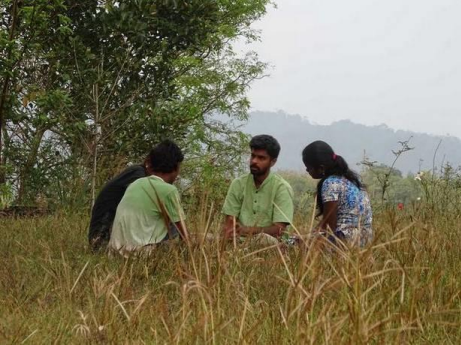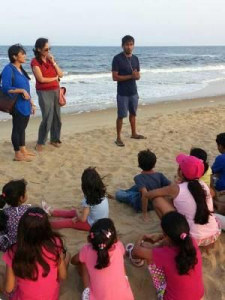V. Arun

The best classroom is the outside world — readily available and for free
* It is the role of teachers to lead students to magic wells and set them off on their own learning journeys
* To study about orchids and bromeliads in books and then to witness them in person in their natural environment is always exhilarating * Once students and teachers learn to use the world as their classroom, the opportunities are endless
The Covid-19 pandemic has forced us to reflect on so much of how we function as a society. In the past year children either accessed virtual classrooms on a mute button, or had fallen off the map entirely due to a digital divide. Either way the question is: Has any real learning happened at all? And can we course correct our method of teaching?
If one were to go back to the drawing board and reflect on what was the best way for education during a time like this, schools as they are now might not come up as an option at all. So what are the broad goals of a school education?
For the sake of brevity, let’s tick two boxes. First, an understanding of how the world functions. This includes acquiring knowledge of various subjects. And, two, developing skills — mental, physical, interpersonal and many others. This includes learning about behaviour, attitudes, values, etc. and engaging meaningfully with peers and adults.
In my opinion, realms of learning, other than the social one, don’t particularly need a school setting. In fact, a study of home-schoolers will reveal how well children excel in educating themselves with or without help from experts. But in terms of acquiring knowledge or building skills, there are multiple ways of going about it. The best classroom ever is the outside world, which is readily available, for free, to learn from. Through our education systems we have made learning a second-hand experience, where we learn just about everything from published materials. A judicious combination of both, the real world and books, will create room for some very exciting learning opportunities.
Learning through observation
As a geography teacher, I have always encouraged students to learn about the phases of the moon by observing it for a month or two to figure out what is happening, either individually or collectively. There are so many things for students to learn here — such as the direction in which to sight it, the time of the day when it rises — always different each day, its changing shapes and so on. To learn these things first hand by direct observation in real time is very rich as it results in palpable learning which is one’s own.
When one is near the ocean, we can learn about tides in the same way. Similarly, one can study clouds, winds, monsoons, soil types, ground water and many more things. All it takes is an observant and curious mind and some recording skills. In biology too, there is so much to learn from direct observation. There is flowering and fruiting of plants and trees, pollination, composting, life cycles of insects, bird migration etc.

We link biology and geography by observing seasons, noting when different trees, shrubs and plants bloom or bear fruit and how the life cycle of insects such as butterflies and moths are linked to those of plants and trees. Students and teachers can create their own knowledge base through recording the host plants (both feeding and egg laying) for different species of butterflies. The same for bird species in terms of flowers they draw nectar from, fruits and insects they eat, trees and shrubs they use to nest.
Branching from this is the whole realm of life sciences of how bodies evolve and adapt to suit their particular life styles. With a strong foundation in direct observation and experiential learning, one can of course keep building on both skills and knowledge.
Magic well
German-Austrian Ethologist, Karl Ritter von Frisch, who won the Nobel prize in physiology in 1973, drew the comparison of drawing from a “magic well” while referring to in depth learning. He was referring to tapping in to a rich source of learning by asking the right questions, making pertinent observations and drawing relevant inferences from that. Once students learn to tap in to magic wells, there is nothing to stop them. The opportunities to explore and learn from the outside world are unending. It is the role of teachers like us to lead students to magic wells and set them off on their own learning journeys.
A wide menu
Students are excited by different aspects of learning. It is important to present a wide menu during early years but, at the same time, it is also important to allow for deep learning by being willing to pursue each topic to the extent their collective curiosity takes them. Not long ago, in a geography class with 13-year olds, we were learning about oceans and marine life. It was from a beautiful book with lovely illustrations and photos that held
deep concepts. The diversity of marine life excited the class, leading us to understand about the extent of light penetration in oceans and its consequences, increasing pressure with depth, drop in temperature, ocean currents and how marine life are adapted to these conditions, using them for their benefit such as sea turtles using ocean currents to migrate. So deep was the learning that we pursued this alone in geography for a whole year. The students were not ready to stop until we had finished the whole book. We also visited the beaches of Chennai and participated in the conservation of olive ridley sea turtles thereby bringing about a direct experience to their learning.

After this book, we engaged in a similar way with a rain forest book for many semesters. We culminated this study with a visit to a rainforest in Wayanad, Kerala, where conservation of rainforest plants was being carried out. To study about orchids and bromeliads in books and then to witness them in person in their natural environment is always magical and exhilarating.
As a teacher I feel it is important that children learn about and connect to the natural world without having to come to terms with all the destruction we have brought about as a species. That needs to come later in their life, but when they are still young and thirsting to know the world it is important to connect to it as naturally and organically as possible.
The above examples just give a little glimpse into what is possible. Once students and teachers learn to use the world as their classroom the opportunities are endless. It also makes learning a dynamic, direct experience and brings immense joy and empowerment to the learner and facilitator alike. As we enter a new year, with a morphing pandemic showing little signs of abating, schools need to reinvent themselves and our curriculum needs reimagining. There is no better time to introduce our children to the beauty of the natural world, rich with possibilities of learning.